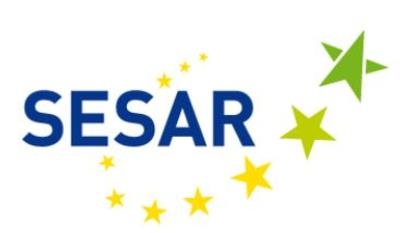Wed, Mar 09, 2016
European Collaboration Demonstrates Use Of Existing Satellite Communication Systems For Enhanced Air Traffic Management
SESAR members together with partners and the European Space Agency’s Iris Precursor have carried out a joint flight trial, successfully demonstrating that existing satellite technology systems are a viable option for air traffic services datalink. The trial showed for the first time how Iris Precursor technology can be used to provide end-to-end air–ground communications for initial ‘4D’ flight trajectory management, connecting aircraft and ATM ground systems to optimise the aircraft trajectory in four dimensions: latitude, longitude, altitude and time. The flight trial further confirms the benefits offered by i4D in terms of increased flight predictability and overall network efficiency.

Carried out by the members of the SESAR Joint Undertaking (SESAR JU), the flight trial represents an important milestone in the continued collaboration between satellite and ATM industries in Europe. The Iris Precursor is the denomination for datalink communications over the existing SwiftBroadband (SBB) satellite network from Inmarsat using the Aeronautical Telecommunication Network (ATN) as the standard protocol for the datalink services implementing rules.
“The flight trial shows what can be achieved by joining forces on European aviation modernisation. The results are clearly in line with the SESAR vision of the future ATM system, as captured by the European ATM Master Plan,” said Florian Guillermet, Executive Director of the SESAR JU.
The SESAR flight trial was performed on the 23 February 2016 on an Airbus A330 MSN871. The aircraft took off from Toulouse, flew over Baleares islands and came back to Toulouse passing above Madrid. During the flight, i4D Automatic Dependent Surveillance-Contract (ADS-C) reports and Controller Pilot Data Link Communication (CPDLC) exchanges were performed with the EUROCONTROL Maastricht Upper Area Control Center (MUAC). It showed how ADS-C contracts could be successfully maintained with two air traffic control centres (MUAC and Airbus Toulouse) for over two hours. During this time, i4D ADS-C reports were generated on event resulting in downlinking trajectory updates approximately every 20 seconds with 20 waypoints - an update rate which is well above the rate expected when initial 4D trajectory exchanges are implemented. In addition to the i4D trajectory exchanges, various CDPLC messages were exchanged along the flight with a remarkable performance rate round trip time of below two seconds throughout the
flight’s duration.
The flight trial also tested the handover between the Inmarsat satellite spot beams, which were completely transparent from the perspective of on-board the aircraft. In terms of connectivity, the trial experienced no loss or provider aborts, a frequent issue with the existing VDL2 terrestrial datalink. Datalink is a key enabler for the SESAR vision, in particular, to implement 4D trajectory-based operations. This flight trial demonstrates that with efficient data link services, flight plans can be continuously updated during a flight to maintain an optimal trajectory to destination, allowing air traffic control to offer better routings, sequence aircraft far in advance, and maximise airport and airspace capacity. It also confirms that the Iris Precursor services based on the Inmarsat legacy network can successfully complement the existing terrestrial VDL2 infrastructure.
By 2018, Iris Precursor is expected to support CPDLC in Europe and open the door to initial 4D trajectory management. In the longer term, Iris will evolve to support full 4D and operate in a highly secure multi-link environment with future terrestrial datalinks. The transition roadmap from Iris Precursor to the future communication infrastructure is currently being addressed by SESAR 2020 - the next wave of research and innovation activities by the SESAR JU - as well as by ESA and Inmarsat (Iris Service Evolution).
(Source: SESAR news release)
More News
Runway Lead-in Light System Runway Lead-in Light System Consists of one or more series of flashing lights installed at or near ground level that provides positive visual guidance a>[...]
Aero Linx: Aviation Without Borders Aviation Without Borders uses its aviation expertise, contacts and partnerships to enable support for children and their families – at hom>[...]
Dave Juwel's Aviation Marketing Stories ITBOA BNITBOB ... what does that mean? It's not gibberish, it's a lengthy acronym for "In The Business Of Aviation ... But Not In The Busine>[...]
From 2010 (YouTube Version): Yeah.... This IS A Really Cool Job When ANN's Nathan Cremisino took over the lead of our Aero-TV teams, he knew he was in for some extra work and a lot>[...]
Also: Junkers A50 Heritage, Montaer Grows, Dynon-Advance Flight Systems, Vans' Latest Officially, the Carbon Cub UL and Rotax 916 iS is now in its 'market survey development phase'>[...]
 ANN's Daily Aero-Term (04.24.24): Runway Lead-in Light System
ANN's Daily Aero-Term (04.24.24): Runway Lead-in Light System ANN's Daily Aero-Linx (04.24.24)
ANN's Daily Aero-Linx (04.24.24) Aero-FAQ: Dave Juwel's Aviation Marketing Stories -- ITBOA BNITBOB
Aero-FAQ: Dave Juwel's Aviation Marketing Stories -- ITBOA BNITBOB Classic Aero-TV: Best Seat in The House -- 'Inside' The AeroShell Aerobatic Team
Classic Aero-TV: Best Seat in The House -- 'Inside' The AeroShell Aerobatic Team Airborne Affordable Flyers 04.18.24: CarbonCub UL, Fisher, Affordable Flyer Expo
Airborne Affordable Flyers 04.18.24: CarbonCub UL, Fisher, Affordable Flyer Expo



